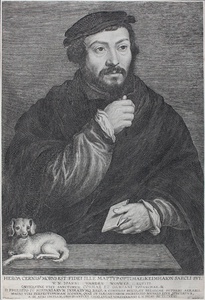| Method | Etching |
| Artist | Lucas Vorsterman I after Hans Holbein the Younger |
| Published | [c. 1631] |
| Dimensions | Sheet 248 x 167 mm |
| Notes |
This finely rendered portrait had long been thought to depict Sir Thomas More, however it is now believed to be portrait of Jan van de Wouwer, although it bears little resemblance to other know portraits of de Wouwer (Joannes Woverius) by Van Dyck, and Rubens' group portrait 'The Four Philosophers'. The sitter looks out to the right of the frame with one hand held up to his beard, the other holding a letter, a small dog sits on the table in front. This fourth state printing of the portrait features a slightly altered inscription of six lines of Latin and Greek text below the image, along with the details of artist and engraver. The text loosely translates as: "Is this to be the fate of the hero and the poor man that he be a martyr to the greatest faith in the winter of his age. / A true likeness of Johannes van den Wovwer, Knight / (who was) toparch of the sanctuary of Saints Cosmas and Damien/ Don Philip IV King of Spain and the Indias, Councillor of War, Supreme Chancellor of Belgium…" Follwed by note for the engraver Vorsterman stating that he has viewed the original painting and has made this engraving on copper. The dedication and text below describes Jan van den Wouwer (1574-1636) but the sitter depicted is not him. Jan van den Wouwer, Wouver or Waverius (1574-1636) was a Flemish scholar, who published works on law and philosophy and also worked as a diplomat. He was appointed the financial advisor to Albert and Isabella, and was an envoy to the court of Philip IV for a year. Lucas Vorsterman (1595-1675) was a Flemish engraver, active in Antwerp. He worked in Pieter Paul Rubens' studio from c. 1617 and soon became the painter's primary engraver. Rubens was a very demanding employer and got in a fight with Vorsterman, after having fired many of the other engravers resulting in more pressure landing on Vorsterman's shoulders. In 1624 Vorsterman moved to England, working for patrons such as Thomas Howard, 2nd Earl of Arundel and Charles I of England, before returning to Antwerp 1630. Back in Antwerp he collaborated with Anthony Van Dyck, for example on the publication of artists' portraits in "Iconographie". Hans Holbein the Younger (1497-1543) was a painter, draughtsman and designer of woodcuts. He also worked with glass-paintings, metalwork, and jewellery. Holbein was born in Augsburg. He worked in Basel as a journeyman at the end of 1515, and was first employed there with Ambrosius by humanist scholars and their printers. In 1519, he was admitted to the painters' guild. With an introduction from Erasmus to Sir Thomas More, he left for England at the end of August 1526, and stayed for two years working in the court circle, before returning to Basel. He returned to England in 1532, and, under the patronage of Henry VIII, he produced a succession of magnificent portraits. The most famous of which was the mural painting glorifying the Tudor dynasty in the Whitehall Palace. It was regrettably destroyed in the fire of 1698. Hollstein 191.iv, O'Donoghue 43 Condition: Printed from a slightly worn plate. Trimmed to image and just below artist and engraver names below, grangerized to album page. Manuscript ink boarder to album page and pencil inscription below image 'Sir Tho.s More-'. |
| Framing | unmounted |
| Price | £250.00 |
| Stock ID | 47326 |

